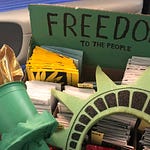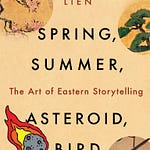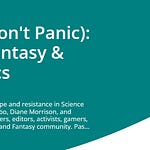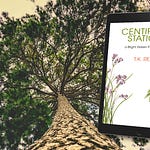Hello Friends!
Welcome to Bright Green Futures, Episode Nine: How to Build a Good Anthropocene.
I created Bright Green Futures to lift up stories about a more sustainable and just world and talk about the struggle to get there.
Today we’re going to talk about how non-fiction and fiction work together to help us envision a better world. But first, I want to talk about how climate fiction is somewhat orphaned in the literary world.
Climate Fiction: Genre Orphan
Science fiction, as a genre, deeply examines the impact of technology on humans, often set in the future or the past. Literary fiction deeply examines the human condition, usually but not always in the current-day world. Climate fiction looks deeply at the human condition in today’s world and tomorrow’s and examines how all of our technologies are altering the world we live in.
If you think those all sound like wildly overlapping definitions, you are correct. And yet, somehow, science fiction and literary fiction have Very Strong Opinions about genre boundaries and what belongs inside their realm and what doesn’t—but they both agree climate fiction belongs outside.
At the same time, both science fiction and literary fiction seem to be relaxing those rigid stances in some peculiar ways.
Science fiction seems to think apocalyptic climate fiction is great, but near-future cli-fi, especially the hopeful variety, is something foreign—unless it’s Kim Stanley Robinson writing Ministry for the Future, because everyone knows Stan is a real science fiction writer! (By the way, Stan is my hero, a brilliant and amazing person, and if you ever get the chance to hear him speak, take it.) Meanwhile, literary fiction seems more open to embracing climate as a reality that has arrived and has a place in our fiction, and literary fiction is particularly open to non-standard forms of storytelling, but whatever you do, don’t show hopeful narratives or call it science fiction (for reasons that make less sense the more you examine it, and I think all of this is mostly about defending genre boundaries).
To be clear: I am not a genre purist of any kind, and I’m against almost all forms of gatekeeping. I’m simply describing a long-standing battle in the literary world over genre definitions because it goes deeper than pedantics. I agree with Amitav Ghosh’s assessment from The Great Derangement, that our inability to bring climate fiction in-house, to embrace it as a serious literary form, whether in science fiction or literary fiction (and climate fiction does belong in both), is a reflection of our inability in the larger culture to grapple with climate change. That goes double for imagining future realities where we are proactively working to solve the crisis, not merely suffering nature’s wrath for our petrochemical sins in entertaining ways, in the case of science fiction, or maudlin ones in the case of literary fiction.
That failure of imagination is no credit to our literary establishment. As Ghosh says, imagination is literally our job.
The Call is Coming From Outside the House
So it’s important to note that the call for more hopeful climate fiction—and the call is growing louder—is coming from outside the house, namely, from climate activism circles.
Scientists, activists, all kinds of non-fiction storytellers, including documentary writers and science writers, people who have long been engaged in the climate battle: these are the people you will hear most fervently calling for more hopeful stories that empower us to action. They’ve spent decades sounding the alarm, sharing the data, and giving logical insights into our impact on the natural world. They’ve produced emotionally compelling non-fiction stories about the devastation and the impact on human lives. And they are frustrated because we are still not acting with the appropriate level of urgency.
These folks are the ones saying we need more hopeful stories about the future, that we need to envision a future worth fighting for. It’s a movement born outside of literature, and I think that’s part of why neither of the two genres to which it most belongs has been eager to embrace it. It goes beyond the prickly nature of writers not wanting to be told what to write: it’s deeply embedded in the stories we tell about the world, the economics of entertainment and storytelling, and even structural problems within storytelling itself.
The difficulty writers have with this mirrors the struggle in the larger culture. If your entire way of life is built around cheap fossil fuels and over-consumption, you’ll reflexively reject anything that says all of that is bad. And not just a minor sin, but destroying the planet level of bad. No one wants to be the villain of the story. And when the only stories on offer are about how humanity should pay for its petrochemical sins, well, we shouldn’t be surprised when people would rather talk about something else. If there’s only room for heroic action and no one person can solve the climate crisis alone, where does that leave us? Seeking entertainment elsewhere, for sure. Even serious literature tells the same story of sin and destruction and revenge. After all, how can you be “serious” while painting a hopeful picture of the climate crisis?
However, I think all of that is shifting.
Partly because the climate crisis has arrived and it’s becoming more widely acknowledged that everyone needs to do something—we all need to do our part. Writers do intrinsically understand the power of storytelling, even if they struggle like everyone else to grapple with the climate crisis itself. The key is for storytellers to do what we do best: tell fresh stories from different perspectives and open up our imaginations to the vast potential for storytelling about this incredible crisis that touches everyone on the planet, reaches into every aspect of society, embodies everything from geopolitics to intimate family relationships, and has the largest stakes imaginable. How is that not a rich source for storytelling?
As someone who writes these stories, believe me, I understand that climate storytelling, especially hopeful climate storytelling, isn’t easy… but it’s challenging in the best possible way. In fact, I think more and more people are bursting to tell these stories, even as the literary establishment struggles to know what to do with them.
How Non-Fiction Can Help
This brings me to climate non-fiction, which has been leading the way for some time, how it differs from climate fiction, and how the two can work together to build even stronger narratives, using the advantages of each.
As a sidebar, I want to note that the trend of non-fiction blurring into fiction and vice-versa is something that’s been happening for a few decades now, across all kinds of genres and mediums. You see it in the rise of youtubers and podcasters and substackers, all deep into the weeds of their particular specialties, all providing a different kind of entertainment. This edutainment, or educational entertainment, is really sense-making in an increasingly erratic and confusing world. There’s a deep logic to seeking out greater understanding of something, even if it’s a hyper-specific specialty topic like hobbyist machining or adventure sailing (to pick my husband’s favorites): it’s that human impulse to grapple with a nonsensical world and make it make sense, if only in the tiny corner that you can control.
Non-fiction has the profound advantage of being real. I don’t need to guess whether you can create an entire working engine from tiny parts machined in a workshop: the youtuber will show me exactly how it’s done. Watching experts do amazing things is intrinsically fascinating and pleasurable.
Dr. Elena Bennett, Associate Professor at the McGill University School of Environment, understands this at a deep level. Her TED talk, The Recipe for a Good Anthropocene, talks about her project to collect up stories of people building a better world. She calls them Seeds of a Good Anthropocene and she has an entire database of five hundred of them (and counting)! I will absolutely link to those in the show notes and I consider it great resource for future stories.
Dr. Bennett has a great quote at the end of her TED talk, and I’m going let her share it with you directly:

“If you want to build a ship, don’t start with collecting wood, cutting the planks and assigning work, but awake in people the longing for the wide and open sea.”— Antoine de Saint-Exupery
And I think maybe it’s time for us to stop cutting planks and assigning work, for me to stop working on increasingly precise descriptions of environmental problems, and for us to start thinking about the radical, inspiring stories of the future that might give us hope and awaken in us a great and hopeful longing for a good anthropocene.
Her entire talk, and her body of work collecting these story seeds, is well worth the watch.
As I said, non-fiction has the incredible power of being true. These things happened. They are real. We are inspired precisely because they throw a lasso around the possibility of change and drag it into the realm of reality.
Those people who are determined to deny the possibility of change will find flaws these stories or caveats or why they might happen there but they can’t happen here, etc etc. None of which stopped the people actually making the change, which is an incredible object lesson in itself. Reality has a stubborn persistence, even in our post-reality age of conspiracy theories and reality-distorting AI. Which is why real-life stories are incredibly threatening to the status quo.
But they’re nowhere near as threatening as fiction, where even more radical change is possible.
Fiction’s Believability Gap
Fiction is easier to dismiss. Simply trot out the words “unbelievable” or “unrealistic” or “utopian” and you trigger a shortcut in our culture and our minds that says: you can safely ignore this. We’re social creatures and the very last thing we want to lose is our status in the group. The threat of being thought ridiculous is severe and will compel many people to reject outright anything that’s “unrealistic” or “unbelievable” or “utopian.” Much in the same way we will reflexively reject anything that makes us the villain of the story (or more accurately, we will flip the roles in our minds so that we are always the rebels fighting the Empire and never the Empire itself).
So fiction—very specifically hopeful climate fiction—has a problem. It has to overcome the believability barrier, which is really a shame barrier, in order to portray stories showing more radical change is possible. It’s actually not enough to show a world worth fighting for, although it’s a really good start to show what people intrinsically want, not just a different world, but a better one. The challenge for the hopeful climate fiction storyteller is to also make it believable.
Now there are many ways to do this—realistic characters and settings, rich technical details, and even grounding your story in familiar events or places—but the real superpower of all fiction is in harnessing lies to tell the truth. The stories are made up. The people are not real. But a story that shows something true has the power to move mountains.
This is where non-fiction can help the climate storyteller—not just in helping to provide story seeds or realistic details, touching grass in a literal sense in your storytelling, but by cracking open the truths that people are experiencing in the real world in the climate crisis. What are the real struggles? Who are the real people who are suffering, fighting the powers that be, overcoming obstacles, inventing new technology and new perspectives, and changing lives all around them?
What are the truths that need to be told about the climate crisis and how we can survive it?
That is the fertile ground where hopeful climate stories will bloom. And if you tell those stories, people will hear the truth and believe that the change you’re describing, the better world you’re evoking, is not only worth fighting for but possible.
I want to share one more video with you, this one a story about telling these stories.
Last fall, I pulled together a panel called Solarpunk on the Screen for a Utopia Conference. Sadly, the conference fell apart. But one of the screenwriters/filmmakers I had tapped for that panel, Taryn O’Neill, producer of Scirens, went on to release a 6 minute short film, which is really a trailer that shows what everyone trying to change the narrative about the climate is collectively trying to do.
The short film is called “The Assignment” and it’s a trailer for The Climate Action Almanac, a collection of stories from the Center for Science and the Imagination at Arizona State University, which you can read online.
Here’s a snippet from the trailer:
You need a network of stories, stories that talk to each other, like patterns on a weave. This is why I collect stories from all the worlds, to see if I can find the real ones, the true ones, and weave them with all the other people engaged in this task. Weave them into something that can make a different world.

Stories have the power to change not just the reader or listener but the storyteller. And that power to change is exactly what we need to get through this time when the world is changing fast, in erratic, terrifying, and unexpected ways.
If we can imagine a better way of being, one that speaks to the deep truths of being human in this complicated world where our inventions—our imaginings—are colliding with the reality of our biosphere… if we can imagine that better way, we can change reality.
Maybe it’s not right to call this kind of story “science fiction” or even “literary fiction” because constraining these stories is the last thing we need to do. Maybe borrowing from the deep canon of non-fiction stories about the climate crisis can help us close the believability gap and ground our hopeful climate fiction in undeniable truths, truths that will combat the naysayers who want to keep the status quo going as long as possible. Their fear of what’s coming is so great, they cannot deal with it at all and retreat into denialism. To be fair, anyone paying attention should be concerned, even afraid of what an increasingly hotter planet really means. But this is precisely what fiction has always done for us: helped us make meaning out of a chaotic and often hostile world. To find the beauty and the joy that are also there.
I don’t care what you call these stories. All I know is that we need to write them.
Bright Green Futures is a weekly newsletter/podcast. Check out the Featured Stories and Hopeful Climate Fiction lists for further reading. The best way to support the show is to subscribe and share the stories with your friends.
LINKS Ep. 9: How to Build a Good Anthropocene
Ministry for the Future, Kim Stanley Robinson
The Great Derangement by Amitav Ghosh
Seeds of a Good Anthropocene website
Youtube trailer: “The Assignment”














